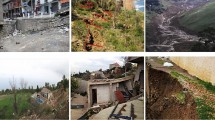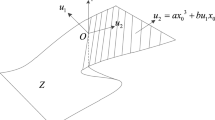Abstract
Many investigations have been conducted to understand the spatial distribution of earthquake-triggered landslides. This paper presents the event-controlling attributes of landsliding in the 2005 Kashmir earthquake event using principal component analysis (PCA) and regression analysis. The earthquake with magnitude M w 7.6 produced 2930 landslides, distributed in an area of about 3250 km2, in the northern part of Pakistan and the Kashmir region. By utilizing SPOT imageries, reconnaissance field survey and geographic information system, the landslide distribution and density were statistically analysed. Controlling factors such as distance from the epicentre, distance from faults, slope steepness, slope aspect, elevation and lithology were considered for the PCA. In order to determine the relationship between different controlling factors, correlation and regression analyses were also taken account of. The results demonstrate that the major effective factors to control the landslide distribution are distance from the earthquake source followed by the slope steepness. Using PCA, distance from the epicentre and distance from the active Muzaffarabad Fault proved to be key influential factors. There is a significant negative correlation between landslide concentration and distance from the epicentre, Muzaffarabad Fault and Main Boundary Thrust. There is a significant strong positive correlation between landslide concentration and slope steepness. The lithology, however, has no significant relationship with landslide concentration.












Similar content being viewed by others
References
Asian Development Bank and World Bank (2005) Preliminary Damage and Need Assessment (Pakistan Earthquake 2005), pp 1–124. http://www.adb.org
Baig MS (2006) Active faulting and earthquake deformation in Hazara-Kashmir Syntaxis, Azad Kashmir, northwest Himalaya, Pakistan. In: Kausar AB, Karim T, Khan T (eds) Extended abstracts, international conference on 8 October 2005 Earthquake in Pakistan: its implications and hazard mitigation—Geological Survey of Pakistan, Islamabad, pp 27–28
Baig MS, Lawrence RD (1987) Precambrian to Early Paleozoic orogenesis in the Himalaya. Kashmir J Geol 5:1–22
Basharat M (2012) The distribution, characteristics and behaviour of mass movements triggered by the Kashmir Earthquake 2005, NW Himalaya, Pakistan. PhD Thesis, University of Erlangen-Nuremberg, Germany
Basharat M, Rohn J (2015) Effects of volume on travel distance of mass movements triggered by the 2005 Kashmir earthquake, in the Northeast Himalayas of Pakistan. Nat Hazards 77(1):273–292
Basharat M, Rohn J, Baig MS, Ehret D (2012) Lithological and structural control of Hattian Bala rock avalanche triggered by the Kashmir earthquake 2005, NW-Himalaya, Pakistan. J Earth Sci 23(2):213–224
Basharat M, Rohn J, Baig MS, Khan MR, Schleier M (2014a) Large scale mass movements triggered by the Kashmir earthquake 2005, Pakistan. J Mt Sci 11(1):19–30
Basharat M, Rohn J, Baig MS, Khan MR (2014b) Spatial distribution analysis of mass movements triggered by the 2005 Kashmir earthquake in the Northeast Himalayas of Pakistan. Geomorphology 206:203–214
Bossart P, Dietrich D, Greco A, Ottiger R, Ramsay JG (1988) The tectonic structure of Hazara Kashmir Syntaxis, southern Himalayas, Pakistan. Tectonics 7:273–297
Calkins JA, Offield TW, Abdullah SKM, Ali ST (1975) Geology of the southern Himalaya in Hazara, Pakistan, and adjacent areas. US Geol. Survey Professional Paper 716-C: 29
Chigira M, Wu X, Inokuchi T, Wang G (2010) Landslides induced by the 2008 Wenchuan earthquake, Sichuan, China. Geomorphology 118:225–238
Dai FC, Xu C, Yao X, Xu L, Tu XB, Gong QM (2011) Spatial distribution of Landslides triggered by the 2008 Ms 8.0 Wenchuan earthquake, China. J Asian Earth Sci 40(4):883–895
Dunning SA, Mitchell WA, Rosser NJ, Petley DN (2007) The Hattian Bala rock avalanche and associated landslides triggered by the Kashmir earthquake of 8 October 2005. Eng Geol 93:130–144
Gallousi CI, Koukouvelas K (2007) Quantifying geomorphic evolution of earthquake-triggered landslides and their relation to active normal faults. An example from the Gulf of Corinth, Greece. Tectonophysics 440(1–4):85–104
Gorum T, Fan X, van Westen CJ, Huang RQ, Xu Q, Tang C, Wang G (2011) Distribution pattern of earthquake induced landslides triggered by the 12 May 2008 Wenchuan earthquake. Geomorphology 133(3–4):152–167
Gorum T, van Westen CJ, Korup O, van der Meijde M, Fan XM, van der Meer FD (2013) Complex rupture mechanism and topography control symmetry of mass-wasting pattern, 2010 Haiti earthquake. Geomorphology 184:127–138
Greco A (1989) Tectonic and metamorphism of the western Himalayan Syntaxis area (Azad Kashmir NE Pakistan) dissertation ETH Zurich, 8779, 1–113
Hussain A, Iqbal S, Nasir S (2004) Geological maps of the Garhi Habibullah and Nauseri area, District Muzaffarabad, AJK: Geol. Survey of Pakistan, Preliminary Map Series Vol. VI, no. 14, Sheet No. 43 F/7,11, 1:50,000
Jadoon IAK, Hinderer M, Kausar AB, Qureshi AA, Baig MS, Basharat M, Frisch W (2015) Structural interpretation and geo-hazard assessment of a locking line: 2005 Kashmir Earthquake, western Himalayas. Environ Earth Sci. doi:10.1007/s12665-014-3929-7
Jibson RW, Keefer DK (1989) Statistical analysis of factors controlling landslide distribution in the New Madrid seismic zone; Tennessee and Kentucky. Eng Geol 27:509–542
Kamp U, Growley BJ, Khattak GA, Owen LA (2008) GIS-based landslide susceptibility mapping for the 2005 Kashmir earthquake region. Geomorphology 101(4):631–642
Kaneda H, Nakata T, Tsutsumi H, Kondo H, Sugito N, Awata Y, Akhtar SS, Majid A, Khattak W, Awan A, Yeats RS, Hussain A, Ashraf M, Wesnousky SG, Kausar AB (2008) Surface rupture of the 2005 Kashmir, Pakistan Earthquake and its role for active tectonic implications. Bull Seismol Soc Am 98:521–557. doi:10.1785/0120070073
Keefer DK (1984) Landslides caused by earthquakes. Geol Soc Am Bull 95:406–421
Keefer DK (2000) Statistical analysis of an earthquake-induced landslide distribution—the 1989 Loma Prieta, California event. Eng Geol 58:231–249
Keefer DK (2002) Investigating landslides caused by earthquakes. A historic review. Surv Geophys 23:473–510
Khan SF, Kamp U, Owen LA (2013) Documentation five years of landsliding after the 2005 Kashmir earthquake, using repeated photography. Geomorphology 197:45–55
Khattak GA, Owen LA, Kamp U, Harp EL (2010) Evolution of earthquake triggered landslides in the Kashmir Himalaya, northern Pakistan. Geomorphology 115:102–108
Khazai B, Sitar N (2003) Evaluation of factors controlling earthquake-induced landslides caused by Chi-Chi earthquake and comparison with the Northridge and Loma Prieta events. Eng Geol 71:79–95
Owen LA, Kamp U, Khattak GA, Harp EL, Keefer DK, Bauer MA (2008) Landslides triggered by the 8 October 2005 Kashmir earthquake. Geomorphology 94:1–9
Peiris N, Rossetto T, Burton P, Mahmood S (2006) EEFIT Mission: October 8, 2005 Kashmir Earthquake. Published Report, The Institution of Structural Engineers, London
Petley D, Dunning S, Rosser N, Kausar AB (2006) Incipient landslides in the Jhelum Valley, Pakistan following the 8th October 2005 earthquake. Disaster mitigation of rock flows, slope failures and landslides. Universal Academy Press, pp 1–9
Planning and Development Department AJK (2013) Azad Jammu and Kashmir at glance. http://ajk.gov.pk
Qi SW, Xu Q, Lan HX, Zhang B, Liu JY (2010) Spatial distribution analysis of landslides triggered by 2008. 5. 12 Wenchuan Earthquake, China. Eng Geol 116:95–108
Rodriguez CE, Bommer JJ, Chandler RJ (1999) Earthquake-induced landslides: 1980–1997. Soil Dyn Earthq Eng 18:325–346
Saba SB, Meijde M, Werff H (2010) Spatiotemporal landslide detection for the 2005 Kashmir earthquake region. Geomorphology 124:17–25
Sato PH, Hasegawa H, Fujiwara S, Tobita M, Koarai M, Une H, Iwahashi J (2007) Interpretation of landslide distribution triggered by the 2005 northern Pakistan earthquake using SPOT 5 imagery. Landslide 4:113–122
Schuster RL, Highland LM (2001) Socioeconomic and environmental impacts of landslides in the western hemisphere: U.S. Geological Survey Open-File Report 2001-276, 47
Ugai K, Yagi H, Wakai A (2012) Earthquake-induced landslides. In: Proceedings of the international symposium
USGS (United States Geological Survey) (2006) Magnitude 7.6-Pakistan earthquake 2005 summary. http://earthquake.usgs.gov/earthquakes
Wadia DN (1931) The syntaxis of the north–west Himalayas rocks, tectonics, and orogeny. Rec Geol Surv India 65:189–220
Wang W, Xu B (1984) Brief introduction of landslides in loess in China. In: Proceedings of 4th international symposium on landslides, Toronto Investiga, vol 1, pp 197–207
Wang HB, Sassa K, Xu WY (2007) Analysis of a spatial distribution of landslides triggered by the 2004 Chuetsu earthquakes of Niigata Prefecture, Japan. Nat Hazards 41:43–60
Xu C, Shyu JBH, Xu X (2014) Landslides triggered by the 12 January 2010 Port-au-Prince, Haiti, Mw = 7.0 earthquake: visual interpretation, inventory compiling, and spatial distribution statistical analysis. Nat Hazards Earth Syst Sci 14:1789–1818. doi:10.5194/nhess-14-1789-2014
Acknowledgments
The authors would like to acknowledge the Director of the Institute of Geology for providing transport facility during the reconnaissance field survey and the University of Azad Jammu and Kashmir for providing research facilities. We would like to thank all anonymous reviewers and editor for their valuable suggestions to improve the quality of this manuscript.
Author information
Authors and Affiliations
Corresponding author
Rights and permissions
About this article
Cite this article
Basharat, M., Ali, A., Jadoon, I.A.K. et al. Using PCA in evaluating event-controlling attributes of landsliding in the 2005 Kashmir earthquake region, NW Himalayas, Pakistan. Nat Hazards 81, 1999–2017 (2016). https://doi.org/10.1007/s11069-016-2172-9
Received:
Accepted:
Published:
Issue Date:
DOI: https://doi.org/10.1007/s11069-016-2172-9




